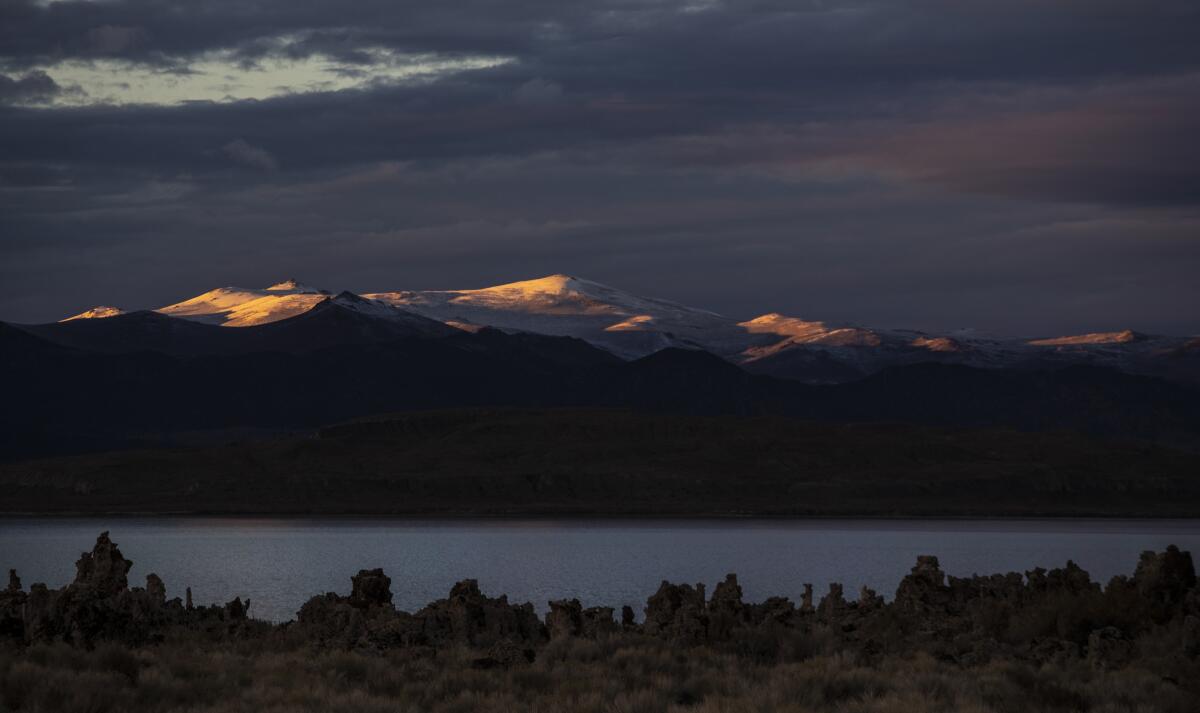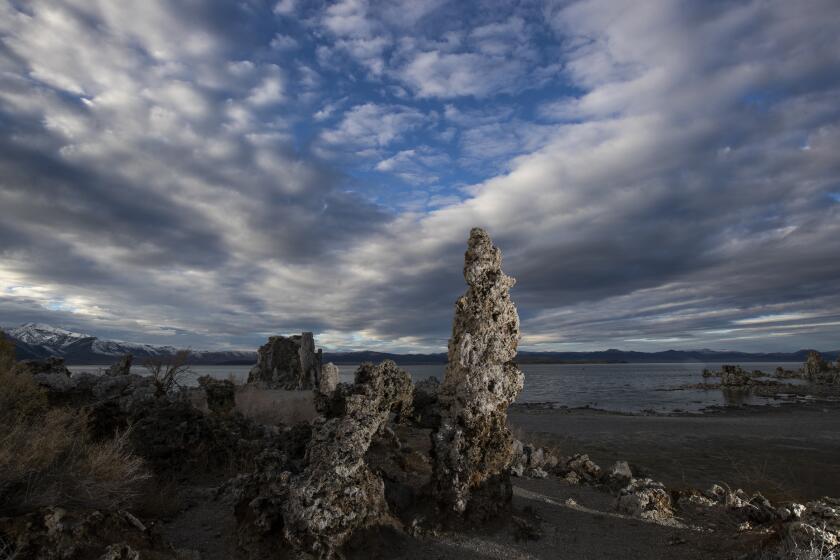Opinion: A wet winter began to replenish Mono Lake. L.A. should let it be a lake again

- Share via
Los Angeles has a once-in-a-lifetime opportunity to restore one of California’s ecological treasures and begin to reverse a century-old habit of relying on water from afar to quench our thirst.
State regulators are considering a pause on water imports from the Eastern Sierra Nevada’s Mono Lake watershed to allow the fragile ecosystem to recover after decades of diversions to the L.A. Basin. Local leaders should embrace the chance to do the right thing for the environment and the Indigenous people who have stewarded this resource since time immemorial.
L.A.’s water managers should also take this step for the region’s sake because importing water from far-flung places is a gamble at this point. As we live through longer and more intense droughts, depending on piped-in water leaves us at the mercy of forces beyond our control. Instead of improving our water security, imports leave us vulnerable to increasingly erratic precipitation.
For decades, the Los Angeles Department of Water and Power has relied on long-standing water rights to divert from the streams that feed Mono Lake.
The best way to ensure every Angeleno continues to have access to clean water is to greatly expand local, resilient water supplies through better planning, education and the best available science and engineering. Local water resilience depends on the “four Rs”: reducing water waste, recycling purified wastewater, restoring contaminated groundwater and reusing urban and storm runoff.
The Los Angeles Department of Water and Power has made huge strides on all these fronts in recent decades. Thanks to public education and a communitywide commitment to making the most of this limited resource, L.A. residents reduced water use by 29% between 2003 and 2020. We can continue this trend with rebates and other policies that help residents replace lawns with drought-resistant landscaping.
The DWP and other local water agencies have also recognized the need to dramatically increase investments in water recycling, which has been growing for decades the world over. The DWP, in partnership with L.A. Sanitation and Environment, expects to generate up to 217 million more gallons of reclaimed water every day by 2035. That’s more than 243,000 additional acre-feet of local water each year, which is about half the city’s annual water use. The California Legislature can help speed up that effort by moving forward with a proposed water resilience bond.
Addressing contaminated groundwater is another key element of shoring up L.A.’s local supplies. The DWP is nearly done with a $600-million effort to clean up the heavily contaminated San Fernando Valley groundwater basin. Once that is complete, the basin will be able to meet a fifth of the city’s water needs.
The region is also finally recognizing that stormwater and other runoff is an essential source of local water. Through the voter-approved Safe Clean Water Program, L.A. County is investing $280 million a year to clean and capture stormwater. The DWP has been quick to take advantage of the program, using the money to support projects that will add 1,700 acre-feet a year to the San Fernando Valley groundwater basin — enough for almost 19,000 Angelenos.
But a truly secure, resilient and equitable water future requires more than shoring up local water supplies. We also must wean ourselves off imported water.
L.A. should honor its decades-long agreement to reduce its water use and therefore how much it diverts from streams that feed Mono Lake.
The easiest place to start is Mono Lake, an internationally critical haven for millions of migratory and nesting birds as well as a scenic recreational destination for Angelenos and other Californians. The DWP made promises to help restore this natural treasure three decades ago but has yet to fulfill them.
After excessive diversions into the L.A. Aqueduct led to the infamous near-collapse of Mono Lake’s fragile ecosystem in the 1970s, a comprehensive review led by the State Water Resources Control Board spurred regulators to limit DWP diversions from the watershed. The board’s order was designed to ensure that the lake would be able to reach and sustain a minimum surface level of 6,392 feet above sea level. That is generally agreed to be the minimum for keeping the ecosystem healthy.
In 1994, the DWP and city leaders agreed to the state’s plan to save Mono Lake. State officials required more water flow to the lake but allowed continuing diversions of up to 16,000 acre-feet annually, which was expected to allow the lake to recover to the target level by 2014. Despite the reduced diversions, however, the lake continues to languish far below the required level. Mono Lake’s return to health is now a decade overdue.
With the lake now benefiting from a tremendously wet winter, advocates have again approached the State Water Resources Control Board with a request to pause DWP imports from the area until the target level is achieved. The Kutzadika’a tribe, the traditional caretaker of Mono Lake and the lands around it, is supporting the effort as a means of protecting its cultural heritage and future.
The harm of continuing to export water from the Mono Lake watershed far outweighs the small benefit to the DWP’s customers. Water diverted from the lake accounts for only about 1% to 3% of L.A.’s water. Keeping it in Mono Lake will protect the ecosystem and, as importantly, fulfill L.A.’s commitment to do so.
The L.A. region needs a radical new approach to water. Importing it from distant watersheds is expensive, energy-intensive and unsustainable. We have the water we need, provided we make the most of every drop.
On bringing the Eastern Sierra’s water to L.A., William Mulholland famously declared, “There it is. Take it.” A more modern, responsible and ethical approach to water management requires a new motto: “It is here! Use it wisely.”
Bruce Reznik is the executive director of Los Angeles Waterkeeper.
More to Read
A cure for the common opinion
Get thought-provoking perspectives with our weekly newsletter.
You may occasionally receive promotional content from the Los Angeles Times.












